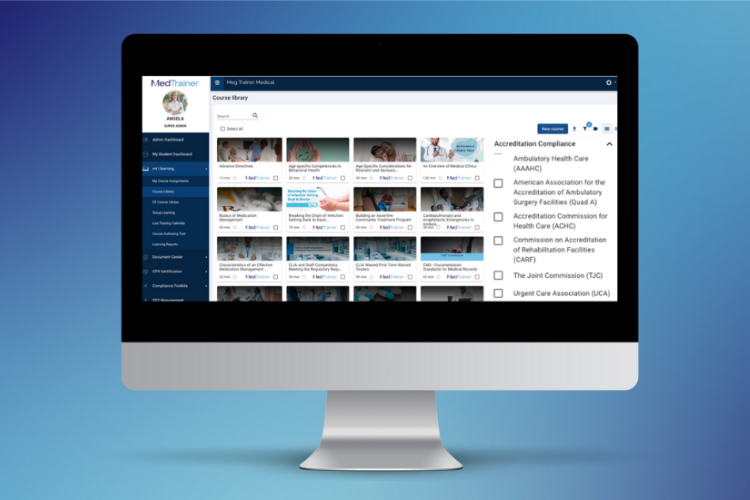You’re considering a compliance learning management system (LMS) because you don’t have time to waste.
You don’t have time to manually send emails, search YouTube for appropriate courses, and take time away from every employee to attend in-person training (that you’ve painstakingly organized).
Your time is worth more. Download this guide to calculate the amount of money you’re spending on your “free” compliance training program.
In this article, you’ll learn the benefits of a compliance LMS and what to look for to make sure you select the best option.
What Is a Compliance Learning Management System?
A compliance learning management system (LMS) is software designed to manage and deliver compliance training and education programs to healthcare professionals and staff. The cloud-based technology stores and organizes courses, provides an online viewing platform, and tracks all associated data. A compliance LMS enables healthcare organizations to keep their workforce trained, aware of compliance obligations, and capable of maintaining high standards of care—all while meeting regulatory requirements.
Why Is a Compliance LMS Important for Healthcare Organizations?
There are tremendous benefits associated with compliance, spanning everything from better patient care to employee engagement and retention. Some of the biggest benefits include:
- Centralized Training Management. When employees in different departments or locations are completing different versions of training, there is no standardized care within a facility or system. A compliance LMS helps to standardize onboarding and ongoing training to ensure everyone receives high-quality, compliant information.
- Risk Mitigation. The tracking and reporting available within a compliance LMS offers confidence that employees have completed training, which indicates they’re prepared for all situations and your organization will pass inspections.
- Employee Retention. A compliance LMS makes it easier for employees to complete training and continuously improve their skills. Employees who feel like their employer is being a good steward of their time will be more engaged and have higher job satisfaction and retention rates.
- Patient Safety and Quality of Care. Online compliance training gives healthcare professionals the ability to reference courses at any point, from anywhere. If they know they need additional training in an area or if they can’t remember a specific best practice, it is easy to go back and watch the course.
Thanks to a LMS, healthcare organizations are able to streamline a very painstaking process and ensure high standards and accountability across the organization.

Simplify compliance training with MedTrainer Learning
How Can a Compliance LMS Help With Regulatory Requirements?
Adhering to regulatory requirements — such as HIPAA, CMS, and OSHA standards — is critical for healthcare organizations and providers, and it’s a standalone reason for investing in a compliance LMS. There’s a direct link between the resources offered by an LMS and the ability of an organization to keep its providers and practices compliant.
With better tracking and automated reminders when training is due, most organizations see compliance rates rise. In fact, with a LMS, Sault Tribe Health Division achieved 99.98% training compliance. They’re also confident the information in all courses has been verified to meet regulatory requirements.
Healthcare compliance LMS platforms offer robust tracking and reporting capabilities, which translate into comprehensive reports for internal audits, regulatory inspections, and compliance assessments. This data is crucial in not only proving compliance, but documenting efforts to standardize and maintain it.
6 Essential Compliance Learning Management System Features
While it’s a powerful tool in keeping organizations and providers compliant, not all LMS platforms offer the same features and functionality. Here’s what to look for when choosing a top-tier LMS:
1. Customization To Meet Specific Organizational Needs
Customization options allow organizations to tailor training content to their specific needs. For instance, creating role-specific courses, incorporating organization-specific policies, and personalizing the learning experience based on employees’ job roles and responsibilities. The ability to create or upload courses specific to your organization and search for them is also a must-have feature.
2. Training Is Focused on Your Industry
It doesn’t matter how many courses a LMS has available if they do not help you meet your industry’s compliance standards. Healthcare organizations need compliance training that meets specific regulatory requirements from organizations such as OSHA, HIPAA, HRSA, and more. And you shouldn’t be left to figure out if a course meets the standard — that’s part of what you’re paying for! A good healthcare compliance LMS will make it easy to search courses based on regulatory requirements, accreditation requirements, and HR compliance. Since most healthcare professionals also need certifications in BLS/CPR, ACLS, etc., select a LMS that also offers these courses.
3. Comprehensive Reporting and Tracking
A good compliance LMS platform provides real-time tracking and reporting capabilities for employees’ progress, course completion rates, assessment scores, and other relevant metrics. Robust reporting makes it possible for you to track compliance training efforts, identify knowledge gaps, and generate reports for regulatory audits and internal assessments. This is a critical feature for auditing and regulatory compliance, and real-time reports help respond to requests from regulators or accreditors.
4. Integration With Other Systems or Software
Choosing a compliance LMS that offers integration and interoperability with other systems is a must-have feature. Look for software that offers existing integrations with HR systems, such as ADP and UKG, so you don’t need to duplicate data entry or risk errors with manual data entry. Seamless exchange of data makes it easier to track and record compliance on a person-by-person basis.
5. User-Friendly for Administrators and Learners
If your compliance LMS is difficult to use, people won’t use it — period. To make sure your organization is getting the most out of its investment in compliance software, select a platform that is intuitive and easily navigable. Beyond an accessible interface, it should also come backed by strong customer support that’s capable of helping you work through problems or even train primary users on the system.
6. Automations To Reduce Manual Tasks
Traditional compliance training is one manual process after another. From sending emails to scheduling to tracking completion in spreadsheets. Let your LMS do this for you! Ensure you’re looking for a platform with automated reminder emails when courses are due and certificate issuing and filing. The more you can automate, the less you need to keep track of manually.
Take Back Your Time With a Compliance Learning Management System
From finding and vetting course material, to emailing staff reminders and tracking employee progress, a lot of time goes into a compliance training program. You can dramatically reduce the amount of time you spend by using a healthcare compliance LMS. As you’ve seen, there are plenty of benefits and you know what to look for.
Need help convincing your boss? Download this free letter, add your organization’s information, and then enjoy some well-deserved free time.
